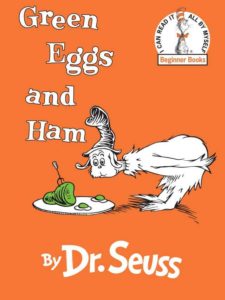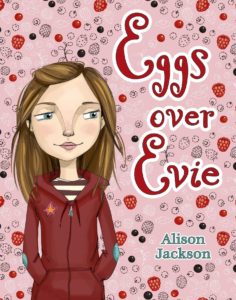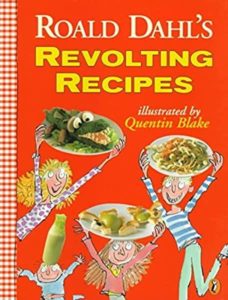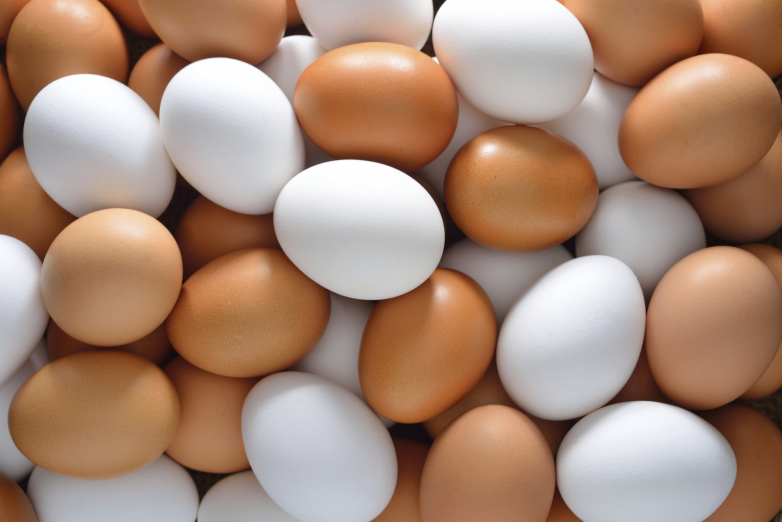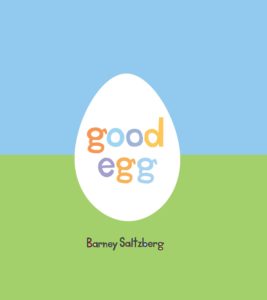 |
Barney Saltzberg’s Good Egg (Workman, 2009) is a delightful interactive book (with Egg). Flaps and tabs operate the egg as it’s told to sit, roll over, lie down, catch, and finally “Speak!” – at which point a bright-eyed chick hatches. For ages 2-5. |
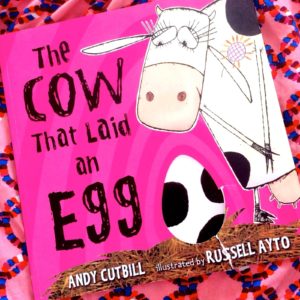 |
In Andy Cutbill’s The Cow That Laid an Egg (HarperCollins, 2008), Marjorie is depressed because she’s just an ordinary cow, and can’t ride a bicycle or do handstands like the other cows. Then – after some clever chickens get to work with a paintbrush – Marjorie wakes to discover that she’s (apparently) laid a black-and-white Holstein-cow-spotted egg. The other cows refuse to believe in Marjorie’s egg and accuse the chickens, who refuse to tell. (“Prove it!”) Eventually Marjorie’s egg hatches a chick – whose first word out of the shell is “Moo!” With hilarious illustrations by Russell Ayto. Pair this one with Dr. Seuss’s Horton Hatches the Egg. For ages 2-6. |
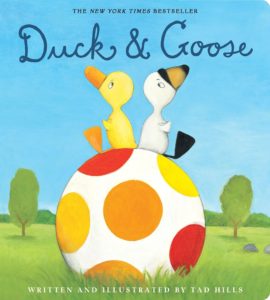 |
By Tad Hills, Duck & Goose (Schwartz & Wade, 2006) features a delightful pair who occasionally have trouble getting along. When they find an enormous spotted egg, both claim it (“I saw it first.” “I touched it first.”). They unite, however, in the process of caring for the egg – and aren’t at all dismayed when they discover that the “egg” is actually a polka-dot ball. One of a series. For ages 3-7. |
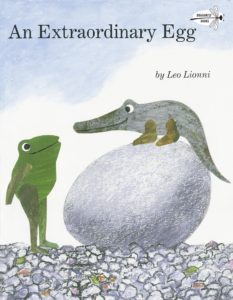 |
In Leo Lionni’s An Extraordinary Egg (Dragonfly Books, 1998), Jessica, an adventurous frog, finds and rolls home an egg – promptly pronounced by her know-it-all friend Marilyn to be a chicken egg. When the egg hatches an alligator, the frogs persist in calling it a chicken and all become friends – though it’s surprising how well the “chicken” can swim. When the baby is finally returned to its mother, the frogs all get a chuckle out of how she refers to the chicken as “My sweet alligator.” For ages 3-7. |
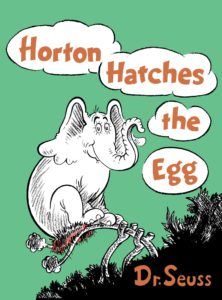 |
In Dr. Seuss’s Horton Hatches the Egg (Random House, 2004), Horton – surely the most lovable elephant in literature – faithfully cares for ditsy bird Maysie’s egg, despite trials, tribulations, and teasing. (“I said what I meant and I meant what I said/An elephant’s faithful, one hundred percent!”) Finally Horton’s much-cared-for egg hatches out an elephant bird. For ages 4-8. |
|
Learn about real elephant birds with David Attenborough and the mystery of the elephant bird. |
|
See these 10 cool facts about the elephant bird. |
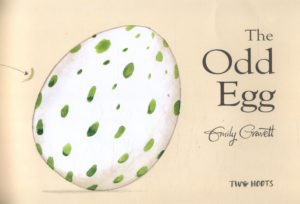 |
I – well – just love Emily Gravett. In Gravett’s The Odd Egg (Simon & Schuster, 2009), all the birds had laid an egg – except Duck. Instead he finds an enormous green-spotted egg and, though all the other birds make fun of it, he persists in waiting for it to hatch (knitting all the time). Finally Duck’s egg produces an enormous baby alligator. The pictures are priceless. For ages 4-8. |
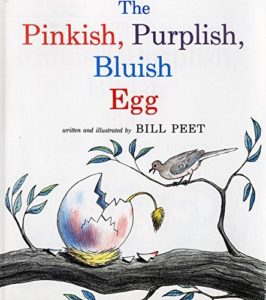 |
In Bill Peet’s rhyming The Pinkish, Purplish, Bluish Egg (Sandpiper Books, 1984), Myrtle, a turtle dove, adopts an enormous and peculiar egg, which hatches out a little griffin. Despite horrified responses from the other birds (“Just look! The thing is half lion, half eagle./I’m sure that it must be unsafe or illegal.”), Myrtle loves the griffin and names him Zeke – and Zeke, grown bigger, heroically saves the birds from a pack of foxes. For ages 4-8. |
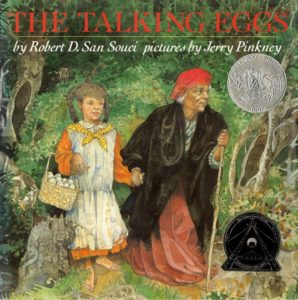 |
Robert D. San Souci’s The Talking Eggs (Dial, 1989) is the adaptation of a Creole folktale featuring two sisters, Blanche (“sweet and kind and sharp as forty crickets”) and Rose (selfish and mean). Kind Blanche helps a strange old lady who gives her some talking eggs that provide her with wonderful things. Rose then sets off to get some eggs of her own, but – since she ignores the old lady’s instructions – ends up with eggs that release only snakes and wasps. With illustrations by Jerry Pinkney. For ages 4-8. |
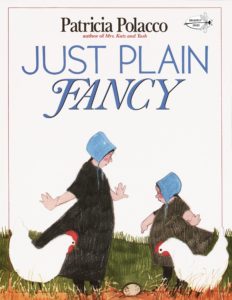 |
In Patricia Polacco’s Just Plain Fancy (Dragonfly Books, 1994), Naomi, an Amish girl, complains that everything about her life – clothes, houses, and chickens – is just too plain. Then she and her sister Ruth find an unusual egg that hatches out a very peculiar chicken. They name it Fancy and try to keep it a secret for fear that the elders won’t approve – until one day. at a working bee, Fancy breaks out of the henhouse and shows himself to be a glorious peacock. (The elders think he’s just fine.) For ages 4-8. |
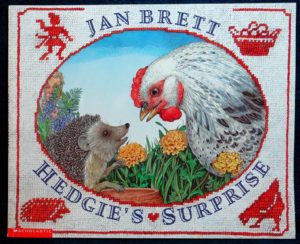 |
In Jan Brett’s Hedgie’s Surprise (Putnam Juvenile Books, 2000), a Tomten – a Scandinavian gnome – is pinching Henny’s eggs, but the problem is solved with some help from a little hedgehog. Wonderful illustrations with Scandinavian needlepoint borders. For ages 4-8. |
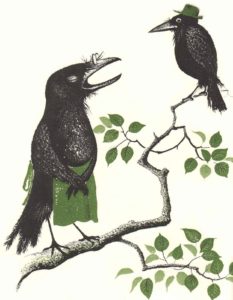 |
In The Crows of Pearblossom (Harry N. Abrams, 2011) – Aldous Huxley’s one and only children’s book – the crows who live in Pearblossom’s cottonwood tree are bedeviled by a rattlesnake, who keeps eating their eggs. Finally, with the help of an owl, they manage to trick the snake with a pair of fake eggs – and then live happily ever after, hatching out four families of seventeen children each. The illustrations are great fun – the crows’ nest, for example, includes a grandfather clock and a bassinet for the egg. A witty read for ages 4-8. |
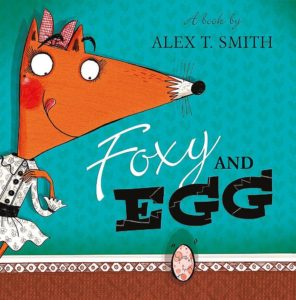 |
In Alex T. Smith’s Foxy and Egg (Holiday House, 2011), Egg shows up on Foxy’s doorstep, and Foxy – who has a cunning plan concerning tomorrow’s breakfast – invites Egg in. She plies Egg with desserts (she wants a large egg), amuses Egg with games (she wants a fit egg), and finally tucks Egg into bed. In the morning, however, Foxy finds that Egg, overnight, has become simply enormous – and then, with a CRACK, Egg hatches out a large green alligator. The pictures add to the humor – for example, Foxy’s house is entirely decorated with chickens. For ages 5-7. |
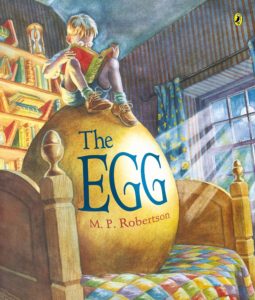 |
In M.P. Robertson’s The Egg (Puffin, 2004), George discovers a truly gigantic golden egg in the family henhouse. He transports it (by wheelbarrow) to his bedroom, settles it on his bed, and reads it stories – and shortly the egg hatches, producing a baby dragon. George now sets about teaching the dragon the essentials of dragonly ways: flying, breathing fire, battling knights, and distressing damsels. The two can’t talk to each other, but they understand each other – as is revealed at the touching and grateful end. For ages 5-8. |
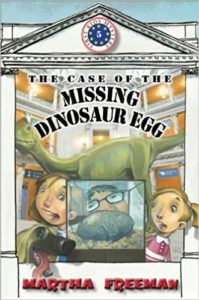 |
In Martha Freeman’s The Case of the Missing Dinosaur Egg (Holiday House, 2013), First Kids Cammie and Tessa – daughters of the first female president – are at the opening of a new dinosaur exhibit at the National Museum of National History, when a supposedly 70-million-year-old egg hatches and – an ostrich chick emerges. Off the kids go to find out what happened to the real egg. For ages 7-10. |
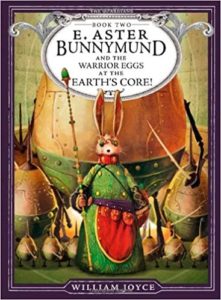 |
In William Joyce’s E. Aster Bunnymund and the Warrior Eggs (Atheneum, 2012), E. Aster Bunnymund – of the brotherhood of the Pookas, philosophical warrior rabbits of great intelligence and size – and his mechanical Warrior Eggs are off to battle Pitch, the Nightmare King. One of The Guardians of Childhood series for ages 7-11. |
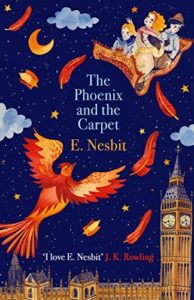 |
In E. Nesbit’s The Phoenix and the Carpet (Puffin, 2012) – originally published in 1904 – five children discover a wonderful egg rolled up in the new carpet that has been purchased for the nursery. The egg falls into the fire and hatches out a fabulous (talking) Phoenix. In company with the Phoenix and the carpet (which turns out to be magic), the kids set out on a series of adventures. (A sequel to Five Children and It.) For ages 8-11. |
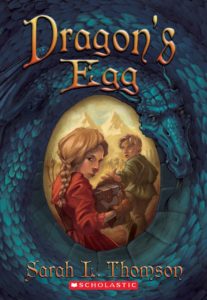 |
In Sarah L. Thomson’s Dragon’s Egg (Greenwillow Books, 2007), dragons are small farm animals – and Mella, who has a talent for dragons, is in charge of caring for her family’s herd. Then a knight arrives, following signs of mythical dragons – the fire-breathing monsters of legend – after which Mella finds a true dragon’s egg in the forest, guarded by a terrifying and enormous dragon. In company with the knight’s squire, Roger, Mella sets off to take the egg safely to the dragon Hatching Grounds. For ages 8-12. |
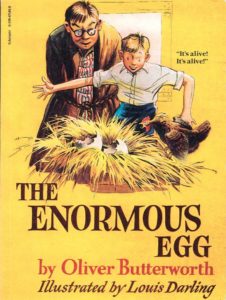 |
In Oliver Butterworth’s The Enormous Egg (Little, Brown, 1993), one of the hens in the Twitchell family henhouse lays an enormous egg – which hatches out an infant Triceratops. Twelve-year-old Nate names the dinosaur Uncle Beazley and decides to raise it himself, but a growing dinosaur proves challenging, so Nate – with the help of a friendly paleontologist – decides to find Uncle Beazley a home. He doesn’t expect the resulting political furor. For ages 8-12. |
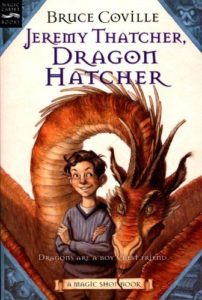 |
In Bruce Coville’s Jeremy Thatcher, Dragon Hatcher (Houghton Mifflin Harcourt, 2007), 12-year-old Jeremy stumbles upon a mysterious magic shop and ends up with a dragon’s egg. Eventually the egg hatches and produces Tiamat, a dragon that only Jeremy and his friend Mary Lou can see. It’s not easy, however, raising an invisible dragon. One of the Magic Shop series for ages 9-12. |
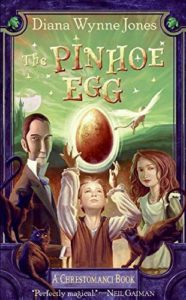 |
By Diana Wynne Jones, The Pinhoe Egg (Harper Collins, 2006) is one of the Chronicles of Chrestomanci series, set in a parallel British universe featuring castles and magic. In this volume, enchanter Cat Chant and young witch Marianne Pinhoe find an incredible egg – hidden for years in an attic – that hatches out a baby griffin. A good bet for fans of Harry Potter. For ages 9 and up. |
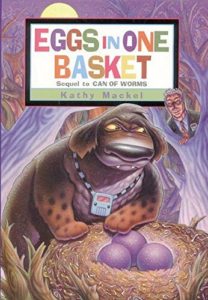 |
In Kathy Mackel’s Eggs in One Basket (HarperCollins, 2006), football star Scott Schreiber – right in the middle of an important game – is blindsided by a horrible screeching noise that nobody but he and Stacia Caraviello (a Weird Band Girl) can hear. It turns out that Scott’s science project – a nest of odd eggs that he found in the woods – really comes from outer space. Scott and friends are soon entangled in an intergalactic battle between the peaceful, but powerful, birdlike aliens, the Lyra, and the evil Shards. And there’s a space security cop who looks like a dog. For ages 11-13. |





















